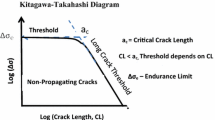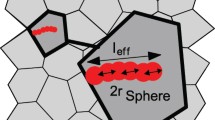Abstract
A crack and a domain of highly fibrillated and stretched material ahead of the crack (process zone), commonly observed in polyethylene, are considered as a system called the crack layer. Slow crack layer growth is assumed to be a result of interactions between the crack, process zone and the rest of the body, as well as of degradation of the process zone material. The energy balance for process zone formation and crack layer advance is presented. The equations governing crack layer propagation are formulated and numerically solved. The proposed mechanism of fracture process models the discontinuous crack growth often observed in polyethylene, and predicts the relationship between the crack growth rate and the stress intensity factor consistent with the experimental one. The dependence of the lifetime on load is discussed.
Similar content being viewed by others
References
Barenblatt, G.I. (1962). The mathematical theory of equilibrium of cracks in brittle fracture. Advances in Applied Mechanics 7, Academic Press 55–129.
Beech, S.H., Channell, A.D. and Rose, L.J. (1995). Slow crack growth performance assessment in polyethylene. 14th International Plastic Fuel Gas Pipe Symposium, 216–225.
Chan, M.K. and Williams, J.G. (1983). Slow stable crack growth in high density polyethylene. Polymer 24, 234–244.
Chudnovsky, A. and Moet, A. (1981a). A theory of crack layer propagation in polymers. ACS National Meeting, New York, 607–616.
Chudnovsky, A. and Moet, A. (1981b). Application of the crack layer theory of fatigue crack propagation in polymers. ACS National Meeting, New York, 617–621.
Dugdale, D.S. (1960). Yielding of steel sheets containing slits. Journal of the Mechanics and Physics of Solids 8, 100–104.
Herzberg, R.W. and Manson, J. (1980). Fracture of Engineering Plastics, Academic Press.
Irwin, G.R. (1957). Analysis of stress and strain near the end of a crack traversing a plate. Journal of Applied Mechanics 24, 361–364.
Kadota, K. and Chudnovsky, A. (1991). Analysis of the fatigue process zone in polyethylene. Proceedings of ASME Winter Annual Meeting, MD-29, 101–114.
Kadota, K. and Chudnovsky, A. (1992c). Constitutive equations of crack layer growth. Polymer Engineering and Science 32, 1097–1104.
Kostrov, B.V., Nikitin, L.V. and Flitman, L.M. (1969). The mechanics of brittle fracture. Izvestia AN SSSR, Mekhanika Tverdogo Tela 4(3), 122–125 (English version).
Knauss, W.G. and Dietmann, H. (1970). Crack propagation under variable load histories in linearly viscoelastic solids. International Journal of Engineering Science 8, 643–656.
Knauss, W.G. and Losi, G.U. (1993). Crack propagation in a nonlinearly viscoelastic solid with relevance to adhesive bond failure. Journal of Applied Mechanics 60, 793–801.
Lu, X. and Brown, N. (1990). The ductile-brittle transition in a polyethylene copolymer. Journal of Materials Science 25, 29–34.
Lu, X. and Brown, N. (1991). Unification of ductile failure and slow crack growth in a ethylene-octene copolymer. Journal of Materials Science 26, 612–620.
Lu, X., Qian, R. and Brown, N. (1991). Discontinuous crack growth in polyethylene under a constant load. Journal of Materials Science 26, 917–924.
Popelar, C.F. Popelar, C.H. and Kenner, V.H. (1990). Viscoelastic material characterization and modeling for polyethylene. Polymer Engineering and Science 30, 578–586.
Popelar, C.H., Kenner, V.H. and Wooster, J. P. (1991). An accelerated method for establishing the long term performance of polyethylene gas pipe materials. Polymer Engineering and Science 31, 1693–1700.
Rose, L.J., Channell, A.D., Frye, C.J. and Capaccio, G. (1994). Slow crack growth in polyethylene: A novel predictive model based on the creep of craze fibrils. Journal of Applied Polymer Science 54, 2119–2124.
Schapery, R.A. (1975). A theory of crack initiation and growth in viscoelastic media. International Journal of Fracture 11, 141–158, 369–387, 549–562.
Schirrer, R., Le Masson, J., Tomatis, B. and Lang, R. (1984). The disentanglement time of the craze fibrils under cyclic loading. Polymer Engineering and Science 24, 820–824.
Stojimirovic, A. and Chudnovsky, A. (1992a). A new thermodynamic model for a process zone in polymers. International Journal of Fracture 57, 281–289.
Slepyan, L.I. (1990). Mechanics of Cracks, Sudostroenie (in Russian).
Stojimirovic, A., Kadota, K. and Chudnovsky, A. (1992b). An equilibrium process zone in polymeric materials. Journal of Applied Polymer Science 46, 1051–1056.
Tam, E.P. and Martin, G.C. (1984–85). Fatique models for glassy polymers. Journal of Macromolecular Science-Physics B 23(4–6) 415–433.
Ungsuwarungsri, T. and Knauss, W.G. (1988). A nonlinear analysis of an equilibrium crack. Journal of Applied Mechanics 55, 44–51, 52–58.
Williams, J.G. (1984). Fracture Mechanics of Polymers, Ellis Horwood Lim.
Author information
Authors and Affiliations
Rights and permissions
About this article
Cite this article
Chudnovsky, A., Shulkin, Y. Application of the crack layer theory to modeling of slow crack growth in polyethylene. International Journal of Fracture 97, 83–102 (1999). https://doi.org/10.1023/A:1018683624720
Issue Date:
DOI: https://doi.org/10.1023/A:1018683624720




